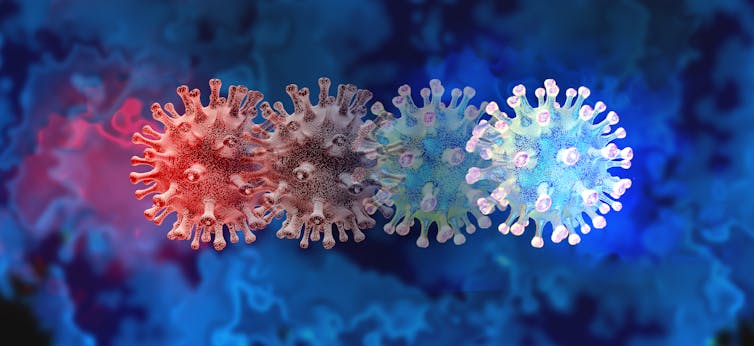South Africa has temporarily halted its rollout of the Oxford/AstraZeneca vaccine after a preliminary study (not yet released or reviewed by other scientists) found it provided limited protection against the South African coronavirus variant for mild and moderate cases of COVID-19. The variant, which has been found worldwide, has presented challenges for all the available COVID-19 vaccines, compromising their effectiveness to different extents.
As virus mutations accumulate in an unfolding pandemic, there is always a danger of them becoming resistant to our natural immune defences, antibody therapies and vaccines. This will naturally happen, as viruses mutate over time.
And with variants of concern identified in South Africa, the UK and Brazil, we can confidently say that more mutations could lead to still more variants before the pandemic is under control.
So how do we best adapt our measures to keep up with coronavirus, and how can we put an end to it?
How new variants emerge
We might not know what the next variant is going to be but we can predict the outcomes of viral mutations.
Let’s suppose I have COVID-19, and a new variant emerges in my body that is much more contagious than earlier forms of the virus.
For new variants to emerge, it helps if they can escape their host’s immune responses. To escape immunity and acquire new attributes, this virus has already been accumulating mutations for a year outside my body: one to two mutations a month, long before I got infected. Once it gets inside, it mutates again. The effect of many mutations accumulated over time lead to the formation of a slightly altered virus, known as a variant. Multiple mutations can even lead to new strains.

So what might my variant look like?
Possible upgrades could include improved binding to cells for more efficient infection, faster replication, increased ability to get around immunity, production of more viruses that reach mucosal sites, such as the airways or the intestines, reduction of direct cell-killing by the virus which leads to prolonged infection, milder infection that allows an infected person to continue to mingle with others, increased stability outside the body, or enhanced infectiousness for younger or older hosts.
All of these are examples of single tweaks that could give rise to a variant of concern and a more contagious virus.
Why does this matter? Because my new version of SARS-CoV-2 could be like the UK variant – more transmissible and with a potentially increased risk of death.
This is no cause for panic, but both scientists like me and the general public have a role to play in the dance between variants and vaccines and there are simple things we can do to prevent a new form of the SARS-CoV-2 getting out of hand.
The challenge for scientists
The advantage of the new vaccine technologies is that they can be updated swiftly to keep up with emerging variants. So our aim should be to reduce the time in which the virus has the advantage on a global scale.
Despite setbacks, efficient global distribution of coronavirus vaccines will help extinguish the emergence of new variants. Vaccines reduce symptoms of infection that spread the virus, and recent evidence from the the Oxford/AZ vaccine shows that it may also reduce transmission.
In the meantime, we need more collaboration between scientists, sharing sequencing results, virus isolates and resources between countries.
Surveillance is critical to track new variants and research is necessary to understand why they may be of concern. Crucially, we also need to confirm whether current precautions, decontamination procedures and therapies are still valid and adapt public health guidelines as necessary.
What can individuals do to help?
It takes time for research to catch up with virus mutations. This is where broad measures come into play.
High transmission rates add fuel to the fire by disseminating new variants more quickly and increasing the chances of more mutations, so efforts need to be made to stop the virus spreading in the community. This means increasing physical distancing and wearing masks even outdoors when coming into contact with people, even when it’s not required by law.
No matter the superpower of my potential variant, I can’t pass it on if I take steps to avoid doing so. To curb asymptomatic transmission, I need to stay vigilant, mask up and avoid unnecessary contacts to protect others until the vaccines are rolled out broadly.
We can get this right
I believe that if we get these behaviour changes right, we can still eradicate this disease with few requirements for vaccine updates over the next few years, and we can keep on top of minor outbreaks from then on. The trick is to stay ahead of mutations and buy time for the vaccines.
We must all act like we are are carrying a new variant, because any one of us might be. This includes people who have been vaccinated as we do not yet know whether current vaccines prevent transmission.
We will only succeed if we take the necessary precautions. The rising death tolls in the countries that underestimated the pandemic compared to those who didn’t, show that we can’t afford to get this wrong.
Zania Stamataki, Senior Lecturer in Viral Immunology, University of Birmingham
This article is republished from The Conversation under a Creative Commons license. Read the original article.

